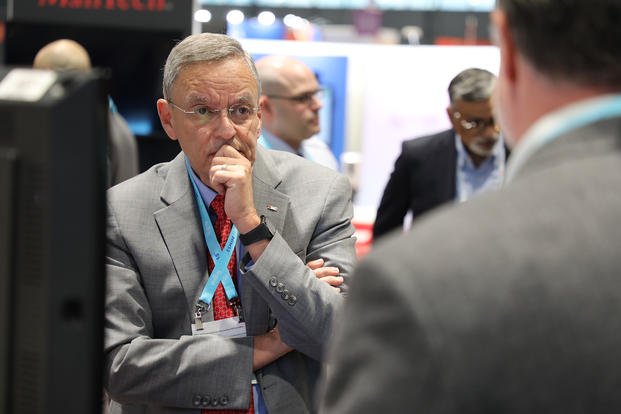

The Defense Department is taking a four-pronged approach to improve military hospitals and clinics following a drop in patient load that has caused providers’ skills to deteriorate.
Assistant Secretary of Defense for Health Affairs Dr. Lester Martinez-Lopez said Tuesday that, with roughly 60% of Defense Department medical care now provided through the civilian Tricare network, the DoD is working to attract staff and bring back patients.
Deputy Defense Secretary Kathleen Hicks issued a memo last December directing the Defense Health Agency to bring at least 7% of patients back to military health facilities by 2026, largely by regaining trust and building a dependable, high-quality workforce.
During a webinar Tuesday hosted by the Association of the United States Army, Martinez-Lopez said that effort is underway, beginning with an overall assessment of the force needed to provide direct medical care to more beneficiaries.
The evaluation of the requirements currently doesn’t exist, according to Martinez-Lopez.
“We have no requirements for force generation in the Military Health System. And we have no requirements for what I call military essential billets, which is the guys in Japan … the guys in [Fort] Irwin [California]. We’re not hiring civilians there; I need to assign military people there … so we’re in the midst of doing the overall study to sort out what we have in hand,” Martinez-Lopez said.
After completing that assessment and a related risk evaluation, the Defense Health Agency can move with step two, hiring civilians, attracting providers to DoD with incentives that would make pay and benefits comparable to those offered by the Department of Veterans Affairs and other federal agencies, Martinez-Lopez said.
To do that, the DoD must reduce the time it takes to onboard personnel — currently, an average of 179 days between a job offer and the start of employment — and ensure that there are military personnel in DoD hospitals and clinics to round out the staff, he said.
“If you need to be in operation in Poland, so be it. If you need to be in a ship in the Atlantic, so be it. But if otherwise, you’re going to be taking care of our beneficiaries in the MTFs [military treatment facilities],” Martinez-Lopez said.
The Defense Department awarded a contract in May worth up to $43 billion to 11 health care companies to provide dental, nursing, physician and medical support to military treatment facilities in the U.S., Guam and Puerto Rico through 2034.
In a panel discussion in May shortly after the contract award, Martinez-Lopez said the agreements were needed because civilian providers remain the “steady force” within the military health system.
“The military guys are moving around every three years; these guys are holding the fortress,” Martinez-Lopez said during a lunch event at the National Press Club on May 22.
By 2026, the DoD will begin the third step, heavily investing in what Martinez-Lopez called “critical MTFs” — those with large populations of active-duty members, retirees and families — to attract patients back to the system.
He believes that, as the department succeeds with the efforts, more will return, given the low-cost care and ease of access to services at military facilities — in most cases, no or low copayments and a one-stop shop for primary care, specialty care and medications at zero cost to the patient.
The fourth leg of the transformation of the direct-care system, he said, will be technology.
The DoD has been slow to embrace user-friendly interfaces that allow patients to make appointments online, message providers or refill prescriptions. The department rolled out an app earlier this year called “My Military Health,” similar to widely used civilian interfaces such as MyChart or HealthLife, at five military health facilities in Georgia, Florida, Virginia and Ohio, but such modern conveniences aren’t available to all who get their health care at a military hospital or clinic.
Martinez-Lopez said the app, improved information technology and telemedicine should bolster the capabilities of military treatment facilities and entice patients.
“Patients call because they have a problem they want to fix. How do we provide that fix? Most patients don’t care. All they care is [that] their problem is fixed. So, we can provide that through technology, we can provide it face-to-face, we can provide it through telemedicine. … We’re going to give the patient the option and make it attractive,” Martinez-Lopez said.
The fiscal 2017 National Defense Authorization Act gave the Defense Department flexibility in reorganizing the military health system, which serves 9.6 million beneficiaries.
Initial reforms called for realigning staff, consolidating health facilities and shedding some 200,000 retiree and family member beneficiaries, as well as 12,800 military health billets in an effort to curb rising health care costs and streamline the uniformed medical corps so its members could focus on active-duty personnel.
At the time, the defense health budget was $48.8 billion, including personnel and construction costs.
The plan immediately received pushback by the services’ top health officers, who said the reorganization was “extremely difficult” and affected care. But their concerns were dismissed largely as turf battles with the Defense Health Agency, the organization now responsible for managing the military health facilities once operated by the services that currently provides administrative, management, training and logistics services for the military health system.
With the level of care declining in military treatment facilities and costs ballooning — the military health budget is now at $55.8 billion — the decisions to shed patients and military providers have been abandoned, however.
Last November, the DoD Inspector General published a management advisory warning the Defense Health Agency that it needed to resolve issues within the system, recommending that the agency review its provider network and survey Tricare beneficiaries and providers to understand where the system may be shortchanging patients.
The DoD IG’s office did not receive a response from Defense Health Agency Director Army Lt. Gen. Telita Crosland “by the time of publication, despite providing an extension of our original deadline for the director to respond,” according to the report.
Martinez-Lopez said he is optimistic that the DoD can build a high-quality health care system that can also train clinicians for battlefield needs.
“It’s a huge elephant, so we have to [take] one bite at a time, small, and then chew it and swallow it,” he said.
Related: Tricare Patients Would See Lower Mental Health Care Costs Under Bill Introduced in Congress
